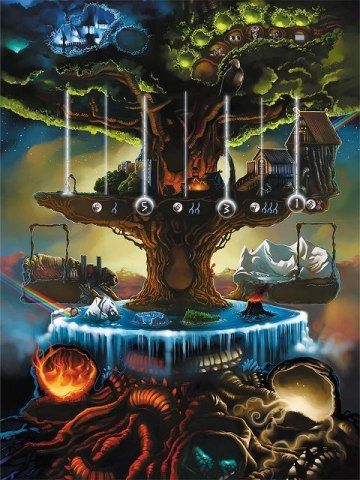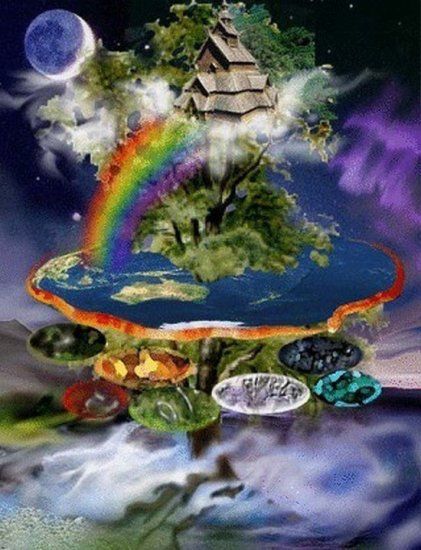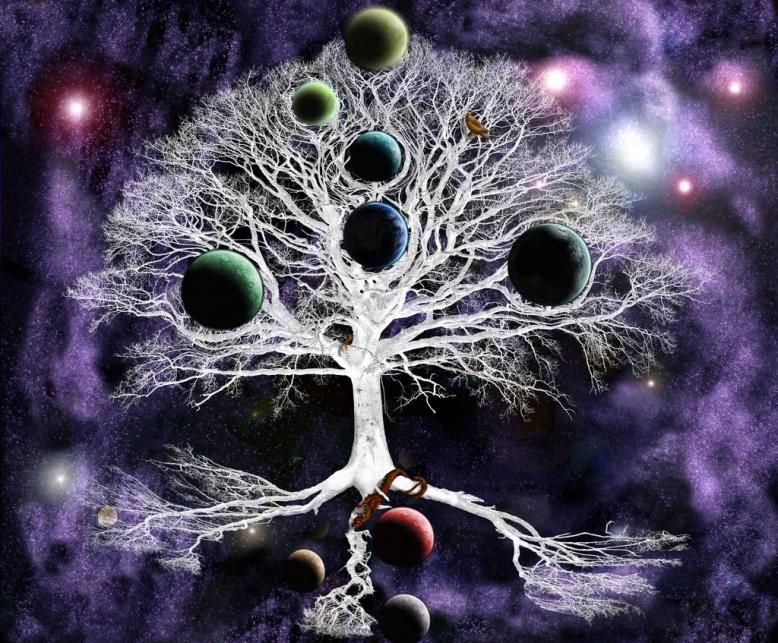The cosmology of Norse mythology has 'nine homeworlds', unified by the world tree Yggdrasill. Mapping the nine worlds escapes precision because the Poetic Edda often alludes vaguely, and the Prose Edda may be influenced by medieval Christian cosmology. The Norse creation myth tells how everything came into existence in the gap between fire and ice, and how the gods shaped the homeworld of humans.
A cosmic ash tree, Yggdrasill, lies at the center of the Norse cosmos. Three roots drink the waters of the homeworlds, one in the homeworld of the gods, the Æsir, one in the homeworld of the giants, the Jǫtnar, and one in the homeworld of the dead. Beneath the root in the world of the frost giants is the spring of Mimir, whose waters contain wisdom and understanding.
The root in the Æsir homeworld taps the sacred wellspring of fate, the Well of Urðr. The tree is tended by the Norns, who live near it. Each day, they water it with pure water and whiten it with clay from the spring to preserve it. The water falls down to the earth as dew.
Animals continually feed on the tree, threatening it, but its vitality persists evergreen as it heals and nourishes the vibrant aggression of life. On the topmost branch of the tree sits an eagle. The beating of its wings cause the winds in the world of men. At the root of the tree lies a great dragon, Niðhǫggr, gnawing together with unnamed serpent at it continuously.The squirrel Ratatoskr carries insults from one to the other. Harts and goats devour the branches and tender shoots.
In the beginning, there were two regions: Muspellsheimr in the south, full of fire, light and heat; and Niflheimr in the north, full of arctic waters, mists, and cold. Between them stretched the yawning emptiness of Ginnungagap, and into it poured sparks and smoke from the south and layers of rime-ice and glacial rivers from the north. As heat and cold met in Ginnungagap, a living Jǫtunn, Ymir, appeared in the melting ice. From his left armpit, the first man and woman were born. From his legs, the frost jötnar were born, making Ymir the pregenitor of the jotun. Most sources identify Ymir's oldest son as Thrudgelmir, who bore Ymir's grandson, Bergelmir. The other jotun are usually unnamed. Ymir fed on the milk of the cow Auðhumla. He licked the blocks of salty ice, releasing Buri.
Buri's son Bor had three sons, the gods Óðinn, Vili and Vé. The three slew Ymir, and all of the jotun (giants) except for Bergelmir and his wife were drowned in the blood. From Ymir's body, they made the world of humans: his blood the seas and lakes, his flesh the earth, his bones the mountains and his teeth the rocks. From his skull they made the dome of the sky, setting a dwarf at each of the four corners to hold it high above the earth. They protected it from the jötnar with a wall made from Ymir's eyebrows. Next they caused time to exist, and placed the orbs of the sun and moon in chariots which where to circle around the sky.
Odin, passing though the world of the jotun, found two beautiful young giants named Sol and Mani, sun and moon. They were brother and sister, and their father had named them after the beautiful lights in the sky. Odin decreed that Sol and Mani should drive the chariots of the sun and the moon across the sky, and to ensure that their journey was always constant and never slowed, he created two great wolves. These wolves were called Hati and Skoll, and they were placed in the sky to pursue the chariots and devour them if they caught them.
The realm of the Norse gods, the Æsir, is called Ásgarðr or the 'Townwall of the Ás'. The Æsir built it after the homeworld of humans, and it contains many halls. Odin's hall, Válaskjálf, is roofed in silver. He can sit within it and view all the worlds at once. Gimli, a hall roofed in gold, to which righteous men are said to go after death, also lies somewhere in Asgard. Valhalla, the hall of the slain, is the feast hall of Odin. Those who died in battle are then raised in the evening to feast in Valhalla. Two important gods, the brother and sister, Freyr and Freyja, are citizens of Ásgarðr but actually exchange-hostages from Vanaheimr. Heimdall, the god's warden, dwells beside Bifröst, the rainbow bridge. Each day, the gods ride over Bifröst to their meeting place at the Well of Urd.
The phrase 'nine homeworlds' is Níu Heimar in Old Norse. Relating to another term heima meaning 'home' or 'homestead', the term heimr means a 'place of abode' in the sense of a homeland or 'region', or in a larger sense a 'world'. These nine homeworlds include the earth, called Miðgarðr, the homeworld where humans as a family dwell.
Source: http://en.wikipedia.org/wiki/Norse_cosmology
Versione Italiana: http://inovemondi.forumfree.it/?t=65831905




No comments:
Post a Comment